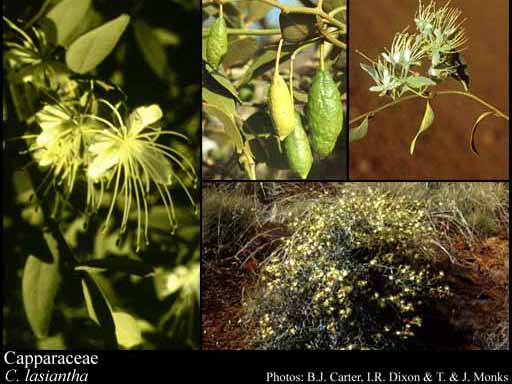- Reference
- Gen.Pl. [Jussieu] 242 (1789)
- Name Status
- Current

Scientific Description
Common name. Caper Family.
Habit and leaf form. Trees, or shrubs, or lianas, or herbs (rarely); non-glandular, not resinous. ‘Normal’ plants. Self supporting, or climbing. Xerophytic (commonly), or mesophytic. Leaves alternate; spiral, or distichous (rarely); petiolate; non-sheathing; gland-dotted, or not gland-dotted; simple, or compound; when compound, palmate. Leaf blades when simple dissected, or entire; when simple/dissected, palmately lobed. Leaves with stipules, or without stipules (stipules small). Stipules (when present) often spiny (or represented by glands). Leaf blade margins often involute. Leaves without a persistent basal meristem. Stem anatomy. Nodes unilacunar. Secondary thickening developing from a conventional cambial ring, or anomalous; via concentric cambia (often), or from a single cambial ring.
Reproductive type, pollination. Fertile flowers hermaphrodite, or functionally male, or functionally female. Unisexual flowers present, or absent. Plants hermaphrodite, or dioecious. Entomophilous.
Inflorescence and flower features. Flowers aggregated in ‘inflorescences’; usually in racemes. The terminal inflorescence unit racemose. Inflorescences usually in racemes. Flowers bracteate; ebracteolate; regular to somewhat irregular; usually 4 merous. Floral receptacle developing a gynophore, or developing an androphore and developing a gynophore (causing the pistil to project). Hypogynous disk present; of separate members (a ring). Perianth with distinct calyx and corolla; 8; 2–4 -whorled (usually more or less resolvable into K2+2 and C4, with decussate calyx and diagonal petals); isomerous. Calyx 4 (2+2); 2 -whorled; basally gamosepalous, or polysepalous; imbricate; bilabiate, or regular. Corolla 4 (diagonal); 1 -whorled; polypetalous (the petals equal or unequal, sometimes hooding). Fertile stamens present, or absent (female flowers). Androecium basically 4, or 6–100 (i.e. to ‘many’, when branched). Androecial members branched (commonly), or unbranched. Androecial sequence determinable, or not determinable. Androecial members when branched, maturing centrifugally; free of the perianth; all equal to markedly unequal; basally coherent, or free of one another. Androecium exclusively of fertile stamens, or including staminodes (or with staminodal branches). Stamens 4, or 6–20; not didynamous, not tetradynamous; isomerous with the perianth to diplostemonous to polystemonous; basically oppositisepalous; filantherous, or petaloid and filantherous. Anthers dorsifixed to basifixed; dehiscing via longitudinal slits; introrse; tetrasporangiate. Fertile gynoecium present, or absent (male flowers). Gynoecium 2 carpelled, or 10–12 carpelled (by dédoublement). The pistil 1–4 celled. Gynoecium syncarpous; eu-syncarpous; superior. Ovary unilocular, or plurilocular; 1 locular (usually), or 2–4 locular (sometimes ostensibly, by false septa). Gynoecium when G=2 transverse. Ovary generally stipitate. Gynoecium non-stylate, or stylate. Styles 1; attenuate from the ovary; apical; shorter than the ovary at anthesis. Stigmas 1; dry type; papillate, or non-papillate; Group II type. Placentation when unilocular, parietal; when bilocular, parietal (but with no replum). Ovules in the single cavity 10–100 (‘many’); when bilocular, 30–50 per locule (‘many’); arillate, or non-arillate; anatropous to campylotropous.
Fruit and seed features. Fruit fleshy, or non-fleshy; dehiscent, or indehiscent; a capsule, or a berry, or a drupe, or a nut, or a samara. Capsules valvular. Seeds endospermic, or non-endospermic. Cotyledons 2 (oily). Embryo variously curved, or bent; 1 the length of the seed, or 2 the length of the seed. Seedling. Germination phanerocotylar.
Physiology, biochemistry. Mustard-oils present. Aluminium accumulation not found. Photosynthetic pathway: C3.
Geography, cytology, number of species. World distribution: widespread. X = 10, 11, 17. 650 species.
Keys
Western Australian Genera and Families of Flowering Plants — an interactive key
T.D. Macfarlane, L. Watson, N.G. Marchant